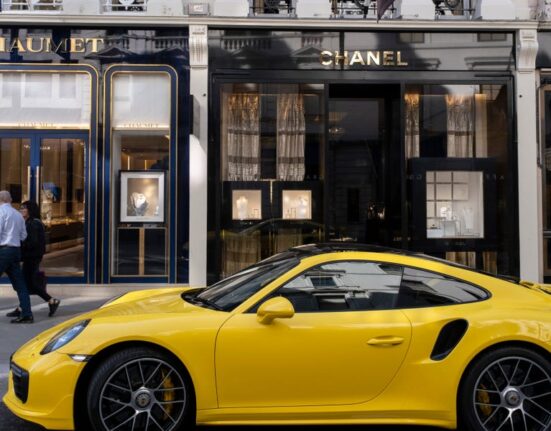Fontainebleau is home to one of France’s most sumptuous and artistically rich palaces, but Picasso seems to have spent his time there not as a tourist, but holed up in a small garage working on two monumental paintings: the cubist “Three Musicians” and the more classical and traditionally representational “Three Women at the Spring.” The stylistic difference between these two works, which were painted at the same time in a space barely wide enough for one American gas guzzler, is the engine driving the show.
“What could Picasso have been thinking of in conceiving, and making, virtually simultaneously and on the same wall, two artworks in such different styles, with such different subjects, on such a grand scale?” asks curator Anne Umland in the introduction to the exhibition catalogue.
Contemporary curators, and perhaps audiences, may find this question more provocative than Picasso did. Like composers, authors, poets, architects and choreographers, the great Spanish painter was capable of working in different modes and styles at the same time. He was, as the curators acknowledge, “style agnostic.” And in 1921, he was both teasing out the implications of his earlier forays into a more stringent cubism and evolving new and more conservative representational approaches.
And the paintings are not so dissimilar as they may at first seem. They both contain three figures, who largely fill the space of the canvas, and while the abstracted musicians face the viewer more directly than the self-engaged women at the spring, there are numerous geometric analogues between the two works — the arm positions of the figures on the right and left, and the columnar leg shapes in both canvases.
Thinking in binary opposites — oppositions such as male and female, light and dark, active and passive — is out of fashion. But if you look at these two works as a single project, exploring basic dualities, then the stylistic differences become much less troubling. Picasso had married three years earlier, and his first son, Paulo, was born in early 1921. The antinomies of male and female, and the product of their union, seem very much on his mind during this period.
Fortunately, the two paintings (including both MoMA’s and the Philadelphia Museum of Art’s versions of “Three Musicians”) are well situated in the exhibition to allow visitors to sort through the cascading dichotomies they represent. Along with male and female, there is the outward and inward focus of the figures, and a sharp distinction between gathering and consuming among the women at the spring, and processing and performing among the male musicians. The women, represented with soft lines, are open to the viewer’s gaze, while the men, limned with sharp edges, wear masks and are defended by a table. The women have gravity and weight, while the male figures are clownish, scattered and disjointed.
Gather all these basic oppositions and you might conclude that Picasso is thinking obsessively if not deeply about what men and women respectively contribute to the world. Women (for the artist) are material, and make material things, like children. Men (or some men) are artists, and process that material into new forms, including abstract shapes and novel sounds.
One may not like these oppositions, which only further deeply entrenched and caricatured ideas about gender. But one can’t spend five minutes with Picasso without realizing how deeply gendered are both his thinking and his art. And if you look closely at works in the exhibition, the birth of Paulo a few months earlier seems to have both rattled and deeply inspired Picasso, unsettling his artistic arrogance as a maker of things, yet spurring a deep fascination with the material, corporeal fact that he had now produced something potentially more substantial and lasting than art.
A series of mother and child figures, made the same summer, is in some ways even more interesting than the contrast between the two seminal works. And one of them, a work called simply “Maternity” from July 10, 1921, is a magnificent, grotesque, disturbing and thrilling showstopper. It depicts Paulo, now preternaturally oversized, cradled in his mother’s lap, with an oversized right hand, and a left hand that has grown so monstrous it looks like something Philip Guston would paint decades later. This is one of a series of paintings he made showing Olga and Paulo in which he seems intent on making motherhood both alluring and disgusting at the same time.
But the July 10 painting goes beyond all the others. If you look closely at the left arm and the left side of Olga’s face, both deeply in shadow, you realize that it isn’t Olga at all, but Picasso himself. The arm has male musculature and the left side of Picasso’s face — and his distinctive, sharply parted hair — has now been fused onto that of Olga. X-radiograph imaging, reproduced in the catalogue, suggests that the artist returned to this painting after its initial conception and made substantial changes in those areas. In any case, once you see the fused male and female figures in the work as it now exists, it is impossible to unsee them.
For visitors who want to get deeper into the weeds of Picasso’s work in the summer of 1921, this exhibition doesn’t disappoint. It uses photographs, drawings, works made both before and after the summer idyll, postcards, maps and memorabilia to give a sense of Picasso’s physical and mental workspace. It even includes a gallery with the same dimensions as the garage in which he worked, with reproductions of the two key paintings hanging where they would have in 1921, according to photographic evidence. A floor plan reproduced in the catalogue details where photographs taken that summer were likely made, and which direction the camera was pointed.
Despite the admirable effort to gather this level of detail, the summer doesn’t seem so complicated to me. Or rather, it is complicated in the way that many lives are complicated, by domestic concerns and the clash of professional and family imperatives. Among the most engaging works in the show are a series of drawings Picasso made early in the summer, of the house and gardens he had just rented. They are exquisite, and charming, renderings of a slightly battered old house with shutters askew and a thick tapestry of vines covering the garden walls. In an interior sketch, Olga sits at a piano, and you sense Picasso’s desire to freeze her just there, forever, in that moment, with music representing the futility of that desire to arrest time.
Even that simple drawing seems related to the dichotomies of the two works, with their contrast between women frozen in a timeless moment and men engaged in the slipstream of temporal existence. It is good to see these major works gathered again, no longer in a garage outside Paris, but in a gallery in New York. But it doesn’t strike me as in any way odd that they were made at the same time, born of an obsession about gender, power and productivity that would consume Picasso throughout his life.
Picasso in Fontainebleau Through Feb. 17 at the Museum of Modern Art, New York. moma.org.







